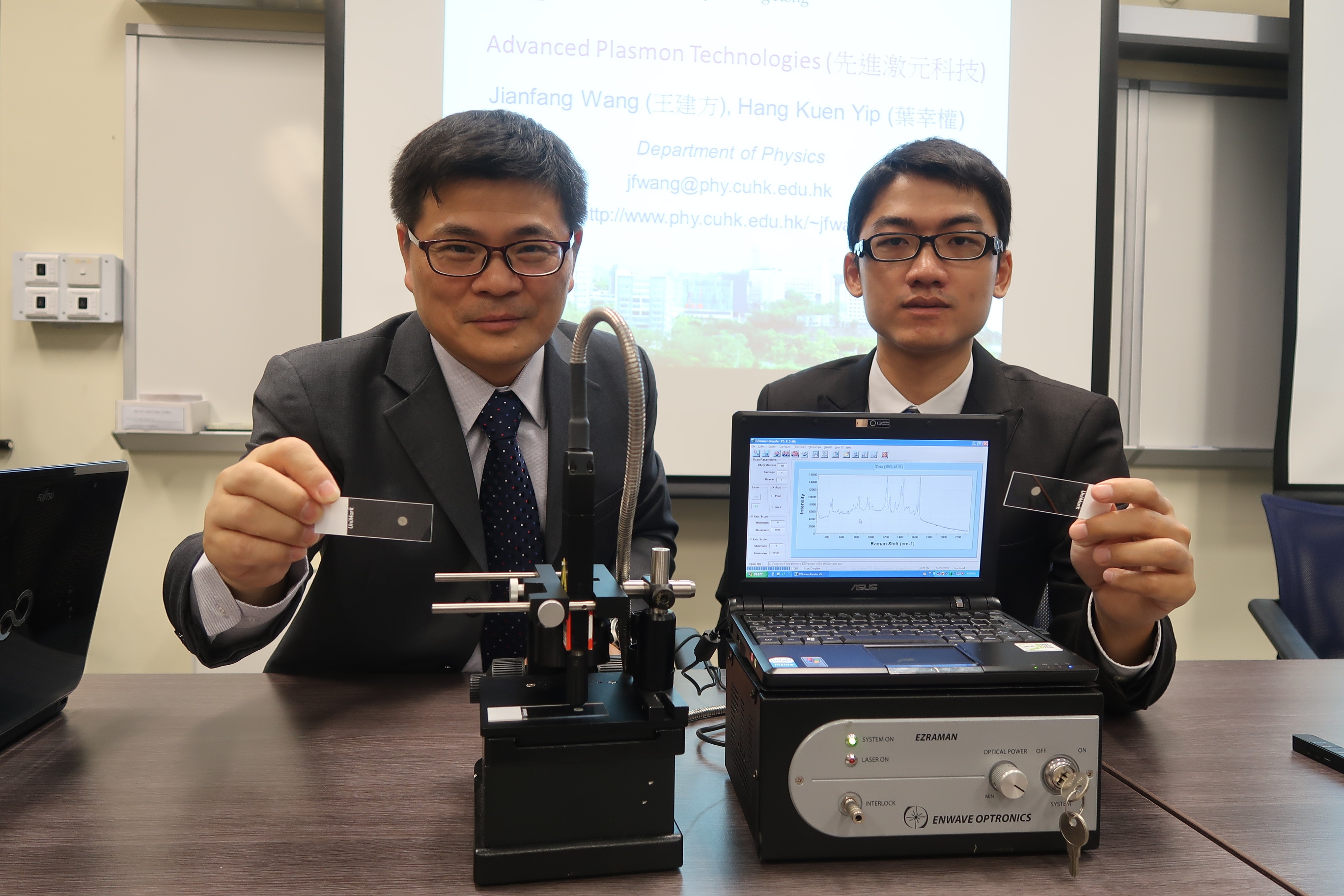CUHK
News Centre
CUHK Develops Low-cost and High-precision Nano Chips WhichMagnify the Surface-enhanced Raman Spectroscopy Signals for Effective Detection of Harmful Substances
Professor Jianfang Wang, Assistant Dean (Education) of the Faculty of Science and Professor of the Department of Physics, The Chinese University of Hong Kong (CUHK), has recently developed a low-cost, high-precision nano chip for Raman spectroscopy. It enables more effective and accurate detection of harmful substances in food, contributing to greater protection and improvement in public health.
“Food safety” is a pressing global topic of great concern. The requirements for food hazard testing have become higher than before. Common toxic ingredients in food such as malachite green and melamine are now within the scope of basic inspection. However, traditional food testing methods have certain limitations. For example, mass spectrometry is expensive and time-consuming, and the types of harmful substances detectable by immunoassay are not enough. In order to cope with the huge demand, it is necessary to develop new testing methods which are low-cost, accurate, fast, and versatile.
The recent emerging Raman spectroscopy method is one of the viable options, because it can accurately distinguish Raman “fingerprints” of different kinds of harmful substances. In addition, the Raman spectrometer used in this method is portable. The smallest model is just like a mobile phone. The sample preparation is easy and the detection process is fast, and it takes only a small sample to provide accurate analysis results. However, to conduct each test, placing the sample on top of an optical chip to enhance the signal is required. The cost of the chip currently sold on the market is quite high.
Improving the popularity of Raman spectroscopy will help secure the “food safety”. Professor Wang – an internationally renowned nanotechnology expert – and his research team applied high-quality gold or silver nanoparticles on glass sheets to make low-cost, high-precision nano chips for Raman spectroscopy. The chips can effectively and accurately magnify the surface-enhanced Raman spectroscopy signals (SERS) of any sample to detect the concentration of harmful substances.
Professor Wang said, “In virtue of our patented technology, we are able to produce the chips in a general laboratory instead of a clean room environment. The size and the shape of our high-quality nanoparticles can be precisely manipulated to maximise their ability to interact with light. So, the cost and the sensing performance of our products are highly promising compared with similar products. We are going to commercialise this technology, and expect to launch it on the market within a year.”
The low-cost, high-precision nano chips developed by CUHK can be applied to any organic and inorganic compounds which can be detected by Raman signals. In addition to malachite green, melamine and other harmful substances commonly found in food, this nano chip can also detect a wide variety of harmful pesticides and additives in food. At the same time, the detection range of the nano chip can be extended to various fields, such as drugs like cocaine and heroin, and even the detection of explosives.
Professor Wang’s team also combined the metal nanoparticles with Vanadium dioxide (VO2) to construct transparent substrates that can control the transmission of near-infrared radiation (NIR), in order to control the room temperature. The substrates are highly promising for the construction of smart windows with a wide variety of applications. After installing such smart windows, the use of air-conditioners can be reduced. Energy savings and emission reductions will then be achieved, which will benefit the environment.
Demonstrating 11 innovative projects at the InnoCarnival 2018
CUHK will participate in the InnoCarnival 2018, organised by the Innovation and Technology Commission of the Hong Kong Special Administrative Region Government, from 3 to 11 November at the Hong Kong Science Park. Members of the public are welcome to visit CUHK’s booth (No. F08) to learn more about the low-cost and high-precision nano chips and see another 10 innovative projects. Interactive games are also available.
|
Date: |
3 to 11 November 2018 |
|
Time: |
10:00 am to 7:00 pm (Sat. & Sun.); |
|
Venue: |
F08, Convention Centre 3, 1/F., 12W, Phase 3, |
Website of InnoCarnival 2018: https://itm.gov.hk/
Professor Jianfang Wang
Professor Jianfang Wang, Assistant Dean (Education) of the Faculty of Science and Professor of the Department of Physics, CUHK is a well-known scientist in nanotechnology and plasmonics. He and his research group have been working on colloidal plasmonic metal nanocrystals since he joined CUHK in 2005. His remarkable achievements have brought him a number of honours, including the 31st Khwarizmi International Award in March 2018, and the Impactful Publication Award 2014-2017 from Princeton Instruments in recognition of his excellent research achievements. He was also honoured by the Ministry of Education with the Higher Education Outstanding Scientific Research Output Awards (2016, First-Class Awards in Natural Science).





